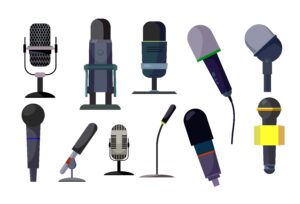If you are looking for the best microphone for your needs, you’ve come to the right place. With so many different types of microphones available, it can be difficult to know where to start. This guide will help you choose the right microphone for your needs by exploring the different types of microphones and their uses, key specifications to consider, and other factors that will impact your decision.
Types of Microphones
There are several types of microphones available, each with their own unique characteristics and uses. Here are some of the most common types of microphones:
- Dynamic Microphones: These are the most common type of microphone and are ideal for live performances and recording loud sound sources like drums or guitar amps.
- Condenser Microphones: These are more sensitive than dynamic microphones and are great for recording vocals, acoustic guitars, and other instruments.
- Ribbon Microphones: These are the most fragile and expensive type of microphone, but they are also the most natural-sounding and are often used for recording vocals or acoustic instruments.
- USB Microphones: These are easy to use and are ideal for recording podcasts, YouTube videos, and other types of content on a computer.

Key Specifications to Consider
When choosing a microphone, there are several key specifications to consider, including:
- Frequency Response: This is the range of frequencies that a microphone can pick up. A microphone with a wider frequency response will be able to capture more detail in the sound.
- Sensitivity: This is how much sound a microphone can pick up. A more sensitive microphone will be able to capture quieter sounds.
- Polar Pattern: This refers to how the microphone picks up sound from different directions. There are several different polar patterns, including cardioid, omni-directional, and bi-directional.
- SPL Handling: This is how much sound pressure a microphone can handle without distorting. If you plan on recording loud sound sources, you’ll need a microphone with a high SPL handling.
Other Factors to Consider
In addition to the key specifications, there are other factors to consider when choosing a microphone. Here are some things to keep in mind:
- Budget: Microphones can range in price from a few dollars to several thousand dollars. Determine your budget before starting your search.
- Intended Use: Consider what you’ll be using the microphone for. Will you be recording music, podcasts, or videos? Different types of content may require different types of microphones.
- Compatibility: Make sure the microphone you choose is compatible with your recording equipment. Some microphones require additional equipment or adapters to work properly.
- Portability: If you plan on using your microphone on the go, consider its size and weight. Some microphones are more portable than others.
In conclusion
choosing the right microphone can make a significant difference in the quality of your recordings, whether it’s for professional or personal use. There are many factors to consider when selecting a microphone, including your budget, intended use, and the type of microphone that will work best for your setup.
It’s important to do your research and read reviews from other users to make an informed decision. With the right microphone, you can capture clear and high-quality audio that will enhance your recordings and presentations.
 Online Hardware Test Online Hardware Test – Tips and Troubleshooting
Online Hardware Test Online Hardware Test – Tips and Troubleshooting

